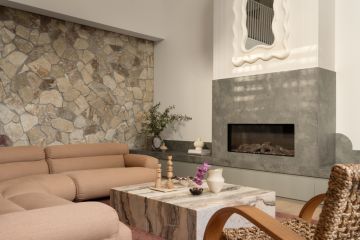I was getting buried in clutter: Here's how I finally got free

With closets overstuffed with clothes that didn’t fit, pots that threatened an avalanche every time I wanted to boil an egg and bookshelves packed two volumes deep, my apartment felt burdened.
Growing piles of rubber tubs made it onerous to clean the floors – especially because my vacuum resided behind bags of miscellaneous “stuff” I shoved into the closet whenever people were over.
Clutter problems in my family vary from the annoying (“I can’t find the city tax bill in these piles of paper”) to the alarming (“I can’t find the remote … and I can’t get near the TV to turn it off manually”). I realised I was heading down a dangerous road.
So when I spotted Marie Kondo’s book The Life-Changing Magic of Tidying Up, I saw hope and committed to digging out.
With an alternately sweet and stern tone, Kondo advocates an all-at-once, “aim for perfection” kind of decluttering. Following Kondo’s “organise by category” advice, I dragged my pots and pans from every nook and cranny; they covered my dining room table and a good deal of floor space. Then my collection sat out for several weeks while I painstakingly figured out which of the four six-quart pots brought me joy.
The “everything in the category at once” method has a clear advantage: You see what you have. You’ll uncover duplication (when did my holiday wrapping paper start procreating?) and get a clear idea of how much space to earmark when you find an ultimate home for the category. If this appeals, I’d highly recommend using an extra bedroom or an empty part of the basement as an out-of-the-way staging area.
But joy was elusive, and getting rid of a few excess pots was surprisingly brain-draining and difficult. In retrospect, it might have helped to look at why I accumulated so much in the first place.
- Related: Love decluttering? You’re probably loaded
- Related: Mistakes people make when decluttering
- Related: The pleasure and pain of decluttering
Why we accumulate clutter
People hold on to objects for three basic reasons, says Randy Frost, a psychology professor at Smith College and the co-author of Stuff: Compulsive Hoarding and the Meaning of Things:
Sentiment: The item reminds them of a person, place or happy time or was a gift from someone they care about. For some people, throwing out something associated with a memory feels like erasing a piece of their life.
Utility: The tendency to keep what “might come in handy someday” comes from fear of waste. Each person’s idea of waste is different and can be complicated by a number of psychological factors.
Aesthetics: People who can organise objects and information may become collectors or artists – but accumulating things we think are “beautiful” without that accompanying organisational ability or desire can merely create clutter.
My own clutter came from a combination of Frost’s reasons. My passion for books and fondness for drinking wine led me to accumulate unopened volumes on oenology. An oil-painting kit sat waiting for me to take lessons, and I held on to two never-used 1950s fondue pots, thinking I might someday own a ski chalet (I haven’t skied in a decade). Cards of pretty sewing buttons I bought sat in a box for two decades, waiting for a shadowbox to hang them in my future craft room.
“Most people understand that they have to choose,” Frost says. “They give up opportunities to take advantage of others. Those who obsessively accumulate stuff – that is, potential ‘opportunities’ – can’t really take advantage of any of them.”
Stephanie Bennett Vogt, author of Your Spacious Self: Clear the Clutter and Discover Who You Are, echoes the idea that clutter clogs our lives in more ways than one. The practice of releasing stuff can help us release other attachments that negatively affect us, like the stories we tell ourselves that don’t serve our goals, she says. As we get rid of what isn’t serving us, we reveal what might. But letting go is definitely harder for some people than others. What might make it easier?
Declutter slowly and steadily
I was able to give away two of the six-quart pots and a number of other pots and pans – eventually.
Maxwell Ryan, co-founder of Apartment Therapy, pointed to the reason I couldn’t do it right away: “Your space is a home because of your deep connection to it and what’s in it. Because you’re so personally invested in your possessions, sudden change – even for good – is like surgery. You can cut quickly, but recovery can be very painful.”
Ryan recommends a more “therapeutic” approach, tackling clutter regularly and progressively. “By pacing the process,” he says, “the internal change – and detachment – happens in tandem with the external change, and the change sticks.”
Gradual change figures into Vogt’s method as well. A couple of months down the Kondo road, I started taking her online course “A Year to Clear.” It boosted my efforts with a gentle, daily “letting go” lesson and helped get me into the habit of “releasing things.”
Tools for detachment
Mary Carlomagno, owner of organising company Order and author of several books on the subject, says it may help to consider that “the things you think you love – like a pair of Gucci booties – can’t reciprocate. That relationship is one-sided.” Instead of hanging on:
Take a photo: Carlomagno likes the idea of taking a photo to keep (“that leather pencil skirt that you were only able to wear once, after you had food poisoning in 1994”) and letting the object go. This solution was a revelation for me when it came to gifts and paper memorabilia – a way to preserve programs from a wedding or an aunt’s teacup without having to find a place for them.
Start an “out box”: For each object, Ryan suggests asking yourself: “Do I use it? Do I love it? Does my apartment need it?” Put any no’s in a designated box. Reassess the contents regularly, and you’ll see yourself detaching from much of what you were initially reluctant to part with. Using this technique, I was finally able to let go of the fondue pots.
Anthropomorphise your stuff: Kondo asks us to consider the feelings of the neglected, unused object in the back of the closet, and, I confess, the thought that something might get more use elsewhere did motivate me to give things away.
Let go of “someday”: I came to realise that it was almost always easier to go to the hardware store than to sift through piles of screws looking for one the right size; that a texted question would quickly get me any geeky grape fact I may have saved those wine books for; that if I hadn’t yet read a novel I’d owned for a decade, I probably wasn’t going to.
Do memorabilia last: This advice from Kondo and Margareta Magnusson, author of The Gentle Art of Swedish Death Cleaning, warns of getting caught up in memories. In my own case, detaching from old photos and greeting cards was much easier when I was already on a roll.
From my modestly sized home, I’ve donated, given away or sold at least 100 bags of stuff – so much that in the first weeks of my efforts, a neighbor assumed I was moving.
Magnusson wrote her book as a how-to, partly to “make life more pleasant” by having less stuff to manage in the final years of one’s life. But to anyone whose “stuff” feels a bit overwhelming, I’d say don’t wait.
Yes, to clean out completely takes time and effort – a year and a half for me (and I’m not through with the photos). But it’s less stressful to open the doors to an organised closet, or to look at bookshelves that have “air.” Most importantly, without the background noise of clutter, I’m finding it is easier to focus, and my writing days are more productive.
“To truly cherish the things that are important to you,” Kondo writes, “you must first discard those that have outlived their purpose.” By letting go of the outlived and unused, I’m keeping my space and head space open for joy to come.
We recommend
States
Capital Cities
Capital Cities - Rentals
Popular Areas
Allhomes
More







